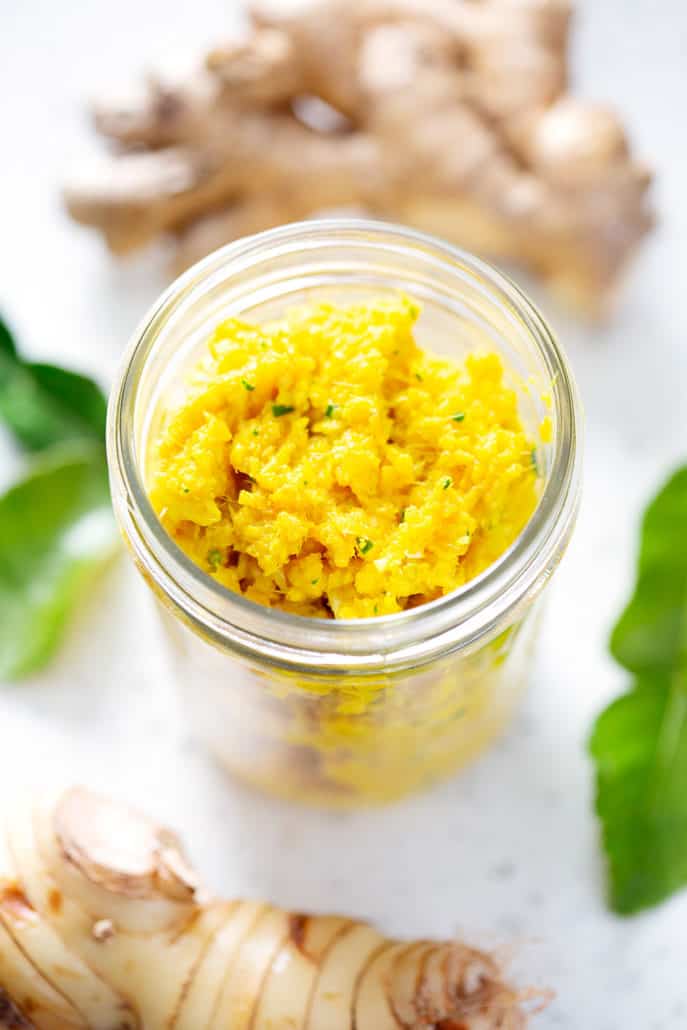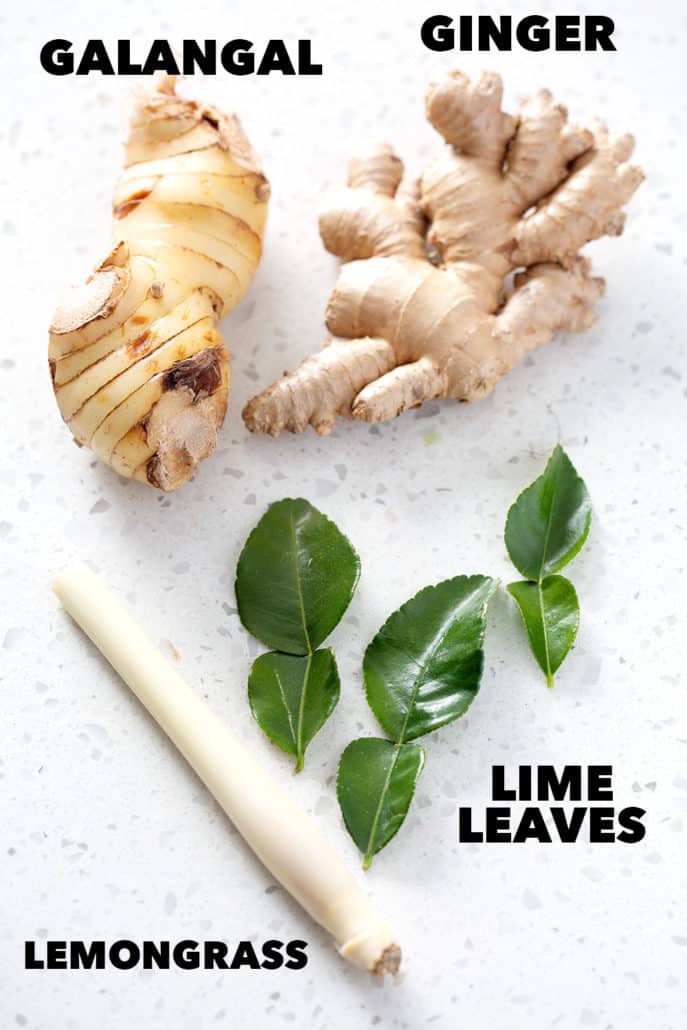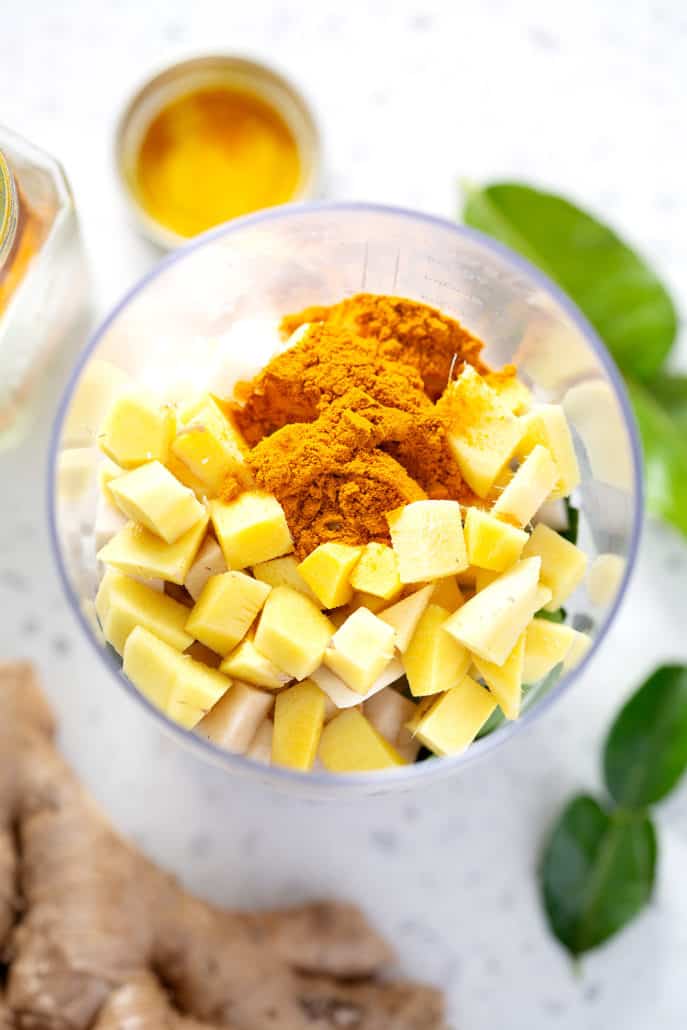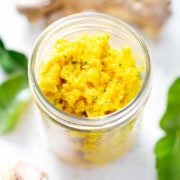This nightshade free AIP Thai Yellow ‘Curry’ Paste is a fantastic base to flavor many different dishes. It’s made with lots of aromatics from turmeric to ginger that are not only anti-inflammatory but also delicious.

There are many kinds of curry and they vary depending upon the family, culture, location and ingredients available. They are two main types of curry: Indian and Thai. Indian is usually a variety of spices ground down into a powder while Thai is usually a paste.
Since so many of these ingredients found in Thai Curry Paste aren’t allowed on the AIP diet, my recipe is really more inspired by the more traditional versions.
Is Curry allowed on AIP?
Yellow curry paste is usually a blend of turmeric, curry, coriander, cumin, lemongrass, galangal, shrimp paste, dried red chilies, sea salt, ginger, garlic and shallots.
Chilies and curry in any form (leaf, powder or paste) is a nightshade. Nightshades are not allowed during the elimination phase. This AIP Curry Paste is nightshade free.
Is Turmeric allowed on AIP?
Yes. Turmeric is an anti-inflammatory. It has potentially therapeutic benefits. [source] The ginger and galangal are in the same family as turmeric and are also anti-inflammatory. [source] In fact, almost all the ingredients in this recipe have anti-inflammatory properties.

All the ingredients in this ‘curry’ are totally aip friendly.
How do you make AIP Yellow Curry Paste
Place all the ingredients into a blender or container for an immersion blender then blend until smooth. It helps to blend one item at a time starting with the onions if you are using an immersion blender.

Tips for making the best AIP Yellow Curry Paste
- Store in an airtight container for about a week.
- If you’re using a food processor you may be able to blend all the ingredients at once. If you are using an immersion blender then it’s easier one ingredient at a time.
- I use this immersion blender.
- I don’t have a food processor but this one is on my wish list.
- This recipe can easily be doubled and frozen in 1 cup containers for use at a later date. Just use within 3 months.
If you like this recipe, you’ll love these other AIP Asian inspired recipes.
- AIP Green Curry Paste
- AIP Coconut Shrimp Curry Soup (this one uses the AIP Yellow Curry Paste as an ingredient)
- Nightshade Free Thai Green Curry Burger (this one uses the AIP Green Curry Paste)
- Turmeric Grilled Shrimp (please note that this recipe includes reintroductions)
- Shrimp Bok Choy and Turmeric Soup
- Chicken and Bok Choy Turmeric Stir Fry
Love seeing my delicious recipes? You can also FOLLOW ME on FACEBOOK, INSTAGRAM and PINTEREST to see more delicious food and what I’m up to.
AIP Thai Yellow Curry Paste
Equipment
- Food Processor or Immersion Blender
Ingredients
- 1-2 Onions peeled and roughly chopped (about 1 cup)
- 4 Garlic Cloves
- 1 Fresh Lemongrass Stalks end trimmed and roughly chopped
- 3 Lime Leaves
- 1/3 cup Fresh Ginger peeled and roughly chopped
- 1/3 cup Galangal peeled and roughly chopped
- 1 teaspoon Fish Sauce
- 1 teaspoon Ground Turmeric or 3 teaspoons Fresh Turmeric
Instructions
- Place all the ingredients into a blender or container for an immersion blender then blend until smooth. It helps to blend one item at a time starting with the onions if you are using an immersion blender.
Notes
- Store in an airtight container for about a week.
- If you’re using a food processor you may be able to blend all the ingredients at once. If you are using an immersion blender then it’s easier one ingredient at a time.
- I use this immersion blender.
- I don’t have a food processor but this one is on my wish list.
Nutrition
Helpful Info for All Recipes
- I always use extra virgin olive oil in all of my recipes unless stated otherwise.
- I always use Himalayan sea salt or Celtic sea salt, unless otherwise noted.
- The majority of my recipes are strict AIP or include notations for reintroductions. However while I make every effort to label non-AIP ingredients and recipes sometimes they slip past me. If you have questions, please ask in advance.
Did you make this recipe? I love hearing your thoughts on my recipes so please rate and comment below.




Would it be possible to use galangal powder instead of fresh? If so, any idea of how much powder to use? Thank you.
I think it would be possible. I just don't know what the amounts. I've never used galangal powder. Honestly, I didn't even know it existed. The packaging may give you some direction and I'd just follow that. And then let me know how it goes. I'm curious to know if it's a good substitute.
I'm not sure why, mine came out very bitter. I'm trying to slow cook it to balance the flavors out. I think it's either the raw lemongrass or the raw galangal. I think if I did this again, I'd blanch the lemongrass before using it and probably roast the onions and garlic in the oven, or even replace the onion with roasted shallots.
I’m so sorry about that. I’ve made this multiple times and never had that issue. And honestly that just sounds strange. Too much lemongrass usually tastes astringent not bitter. I’m not even sure why that would happen. However you can try adding some citrus or vinegar to help temper the bitterness.
I came on here looking for a curry paste ideas to use up a ton of fresh turmeric I have and saw your comment. I cook mostly Vietnamese, Korean, and Indian food and have for many years. First and foremost, recipes should say what type of onion to use. For this recipe I would use yellow onion (Vidalia as backup) and I would soak sliced onions in room-temp water for 10-15 minutes before, strain, then blend -- this will pull some of the bitterness out (a phở approach). Second, to answer your question, you would need about 8 teaspoons of galangal powder to replace the 1/3 cup of fresh here. Also... spend the extra money on GOOD fish sauce as some of the cheaper ones can taste off-putting. Lastly, you could try to pickle the ginger the night prior or purchase jarred pickled ginger and use the meat only. That definitely pulls the bitter out of the ginger but leaves you with a sweet gingery taste. That is my go-to when cooking quick curries. Whole Foods in the Asian section and any Asian market will sell pickled ginger jars. Hope this all helps.
First, I always use yellow onions in my recipes unless I specific a specific type. And I've never found onions to be bitter which is why I don't require any additional steps. And I realize that onions can taste bitter, it's not common. There are multiple reasons why it could turn out bitter so it's hard to tell without being in the room and watch someone make it. Please note that if you soak the onions, it might change the taste and then I can't vouch for the recipe as you have not followed my instructions.
Second, unlike the turmeric, galangal makes up a good amount of the recipe. I would hesitate to substitute it with powder but you're welcome to try it. However, making this substitution might change the taste of the recipe and then I can't vouch for it as you have not followed my instructions. If I get a chance to test the recipe with powder as a substitution, I'll make sure to include it in the notes.
Third, I highly recommend Red Boat Fish Sauce. You can purchase it here.
And finally, I would not recommend jarred pickled ginger. I have never found jarred pickled ginger, especially in an Asian market, that fits the AIP or even Paleo diet. It usually has refined sugar and artificial food dye. Fresh ginger is recommended and relatively easy to find in most large grocery stores. Again, making this substitution might change the taste of the recipe and then I can't vouch for it as you have not followed my instructions.